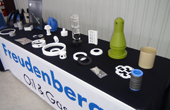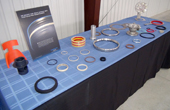Freudenberg labs target thermal cycling, HPHT, material properties, sour gas, product testing
Richard Schmidt, president and CEO of Freudenberg Oil & Gas, speaks with DC editorial coordinator Katherine Scott about Freudenberg’s new material and product testing facility in Houston.
By Katherine Scott, editorial coordinator
Freudenberg Oil & Gas launched its newly constructed, 14,000-sq-ft material and products testing facility in Houston on 23 January. Within the facility are five specialty labs with comprehensive testing labs for thermal cycling, high pressure/high temperature (HPHT), material properties, product testing and sour gas. A sixth lab, for rubber mixing, is expected to be completed by June.

With these testing labs, Freudenberg will be able to perform in-house product verification testing and the company’s own sealing products, as well as customer projects. Christoph Mosmann, member of the management board for Freudenberg Group, noted that the Germany-based company is taking a long-term approach to the business.
“We are patient enough to build step by step, and this lab speaks for the technology we want to provide our customers,” Mr Mosmann said. The new facility was a $1.5 million investment and took approximately a year to construct.
In the thermal cycling lab, rated for 15,000 psi and 250°F, an environmental chamber, gas booster and accumulator vessel help product function testing for sealing solutions such as spring seals, T-seals and FS seals. Within the chamber, temperatures can range from -100°F to 375°F.
The HPHT test lab, rated for 15,000 psi at 430°F, uses rapid gas decompression testing to assess material and function of products such as O-rings, spring seals and T-seals. The lab includes insulated, self-contained test vessels with band heaters between vessel and insulation. “There are about 10 cycles that we’ll subject the seals to, and afterwards we’ll take the fixture out and cut the seals into equal quadrants and analyze them for cracking, blistering, splitting,” Monica Villescas, chemist for Freudenberg Oil & Gas, explained.
Physical testing is performed in the material properties test lab, which is equipped with a tensile tester that reads whole data curves at once and connects to a computer for data storage and analysis.
The product test lab is rated to 15,000 psi at 350°F and was designed to function-test products such as BOPs and ram packers. It is capable of testing a full 13-in. BOP. “We’re not just going to pressure-test the BOP, but we’re going to actuate the BOP, and basically actuate anything else that we would put our seals on,” Kairy Otero, mechanical engineer for Freudenberg Oil & Gas, said.
Finally, the sour gas test lab, for up to 15,000 psi and 4430°F, will test a spectrum of gases and fluids, as well as customer-specific combinations. Material and function tests include atmospheric pressure to 2,000 psi and immersion testing to 15,000 psi, as well as Norsok M-710 sour gas testing.
The yet-to-be-finished rubber mixing lab will focus on developing new material recipes.
Image Gallery
Click any image to zoom










